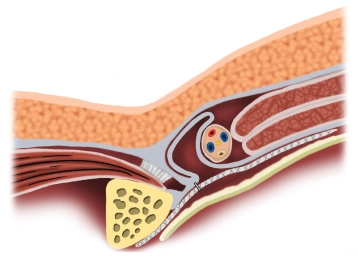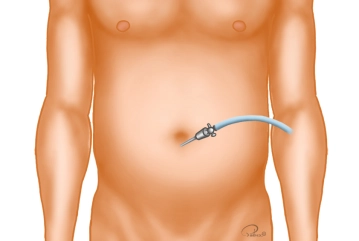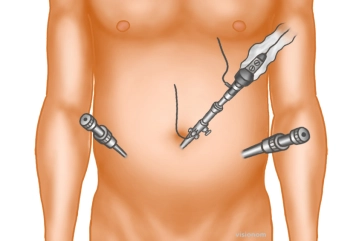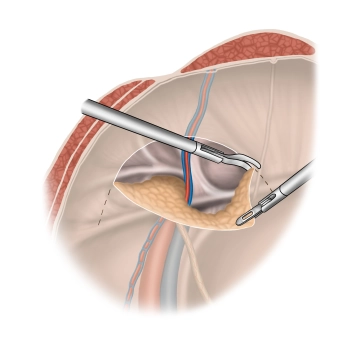Reinforcement of the posterior wall of the inguinal canal by laparoscopic insertion of a synthetic or biological mesh placed preperitoneally.
-
Principle
![Principle]()
-
Creation of Pneumoperitoneum
-
Trocar positioning
![Trocar positioning]()
Soundsettings The optical trocar (10 mm) is introduced bluntly with scissors after entering the abdomen and the abdominal cavity is inspected. Then, under direct vision, additional trocars are inserted laterally on both sides approximately at the level of the navel: a 5 or 10 mm trocar on the hernia side, and a 5 mm trocar on the opposite side.
Tip: The camera is guided so that the 30° optics face ventrally. This is the only way to obtain an overview of the posterior inguinal region.
Remark 1: If no inguinal hernia is visible upon inspection of the inguinal region, preparation should still be carried out, as the symptoms could be caused by the prolapse of a spermatic cord lipoma.
Remark 2: After placing the trocars, the operating table is positioned in the Trendelenburg position so that the intestines can be shifted to the upper abdomen and tilted 20° towards the surgeon to allow for better ergonomic working conditions.
-
Peritoneal incision and preparation, presentation of the anatomical "landmarks"
![Peritoneal incision and preparation, presentation of the anatomical "landmarks"]()
Soundsettings The incision of the peritoneum begins after palpation from the outside in the area of the anterior superior iliac spine, runs in an arc 3-4 cm above the internal inguinal ring over the epigastric vessels, and ends at the medial umbilical fold. The fold itself should not be transected.
Note: Asymptomatic adhesions in the lower abdomen do not need to be resolved, as the actual hernia procedure is performed preperitoneally.
Medial to the epigastric vessels, dissection is performed between the bladder (beware of bladder injury) and the posterior rectus sheath to expose the dorsal side of the symphysis and the Cooper's ligament. Then, the peritoneum is bluntly dissected caudally from the epigastric vessels, the vas deferens, and the spermatic cord vessels.
Detachment of the hernia sac and peritoneum from the spermatic cord structures and the transversali
Activate now and continue learning straight away.
Single Access
Activation of this course for 3 days.
Most popular offer
webop - Savings Flex
Combine our learning modules flexibly and save up to 50%.
US$86.33/ yearly payment
general and visceral surgery
Unlock all courses in this module.
US$172.70 / yearly payment





